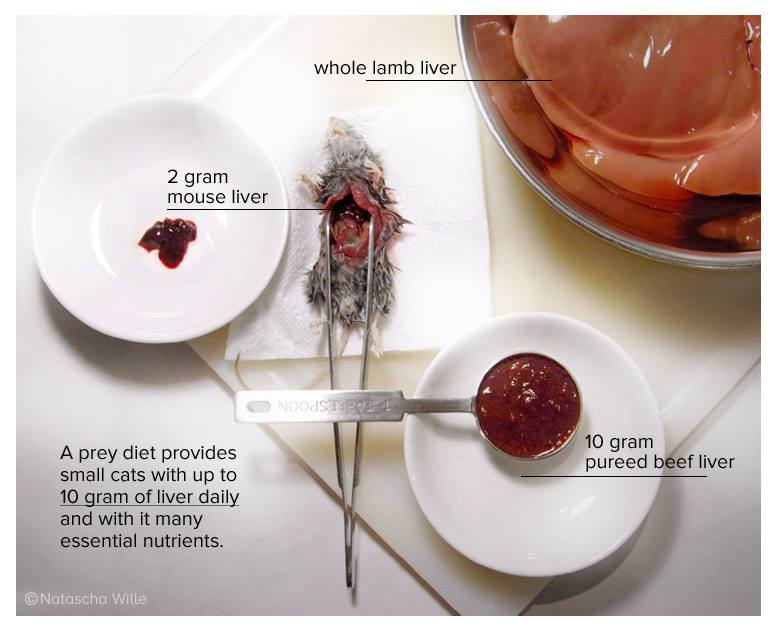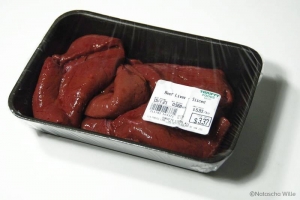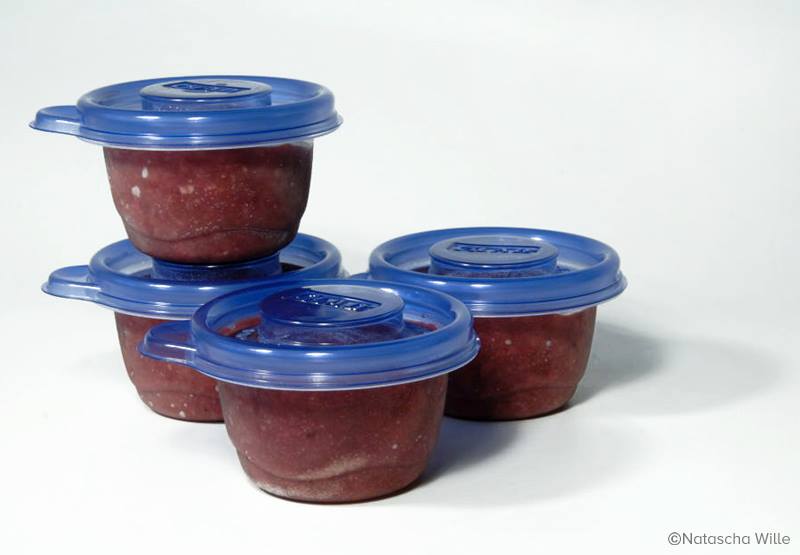Why feed liver, and why so much?
The raw cat food I have developed is modeled after a prey diet – although it doesn’t resemble a mouse much anymore. Many key components of the diet rest on the prey model foundation nonetheless. Inclusion of liver is one of them.
The liver of an adult mouse weighs up to 2 gram and we know that an adult cat will consume up to 5 mice to meet her energy needs. This results in a total of 10 gram of fresh liver consumed daily by a cat eating a truly natural diet. Over a period of 10 days, that totals 100 gram of liver, which is why my raw cat food recipe and the instructions for using the Original premix call for 100 gram of fresh liver per batch – which equals 10 days worth of cat food.
Nutritional analyses of mice and liver have also indicated that the vitamin A content of 50 mice (10 days of food) is equal to 100 gram of beef liver (included in a 10 day recipe of cat food), which is roughly 10,000 IU.
Liver is an essential part of the diet for cats, because it delivers nutrients not readily available in other tissue. Vitamin A and D being the most prominent ones of these – neither of which the cat can synthesize like other animals can. The B vitamins are supplied through liver, as are important trace minerals like Iron and Copper. Liver tissue also holds a supply of glycogen – one of the very few sources of glucose (carbohydrate) available to the cat, which can be directly absorbed into the blood stream without causing bacterial overgrowth in the lower digestive tract as is common when feeding carbohydrates from plant source.
 It turns out that sourcing liver can be a challenge. If you do not see fresh liver available in your grocery store, then inquire about it with the meat department manager. Often, liver and other organ meats are stocked only on certain days and can also be ordered specially if you are willing to take a certain quantity of it.
It turns out that sourcing liver can be a challenge. If you do not see fresh liver available in your grocery store, then inquire about it with the meat department manager. Often, liver and other organ meats are stocked only on certain days and can also be ordered specially if you are willing to take a certain quantity of it.
 Once you have sourced the liver, it is usually packaged in quantities far greater than what is needed for preparing a batch of cat food. This doesn’t matter and may be to your advantage.
Once you have sourced the liver, it is usually packaged in quantities far greater than what is needed for preparing a batch of cat food. This doesn’t matter and may be to your advantage.
Large quantities of liver do not have to be utilized right away. You don’t have to make a huge batch of cat food all at once. The liver can be divided into portions and frozen for later use. It is absolutely okay to freeze liver, thaw it for use in cat food, and then to freeze it again as part of the cat food.
Before freezing liver in portion sizes appropriate for a batch of cat food, I like to grind it first. Cutting liver into small cubes is an arduous job which I would refrain from. Ground liver also flavors the cat food evenly and helps to disguise supplements in the mix your cat may not be overly fond of. Grinding liver gives a far superior texture than running it through a blender or food processor. When pureeing liver in a blender or food processor it is often whipped up too much and turns a beige color with a putty texture. Blood vessels in the liver are often not cut in the blender or processor and are left as unsightly stringy bits. When ground, liver retains its rich red appearance and has a even and easy to mix soupy texture.
After grinding, freezer the liver in 100 gram or 1/2 cup portions in containers you find most convenient. I like the little 1/2 cup freezer containers or silicone baking molds. You may be able to stash away enough liver to make 6 or more future batches of cat food that way and the idea of including fresh liver in your cat’s food isn’t so inconvenient anymore.

